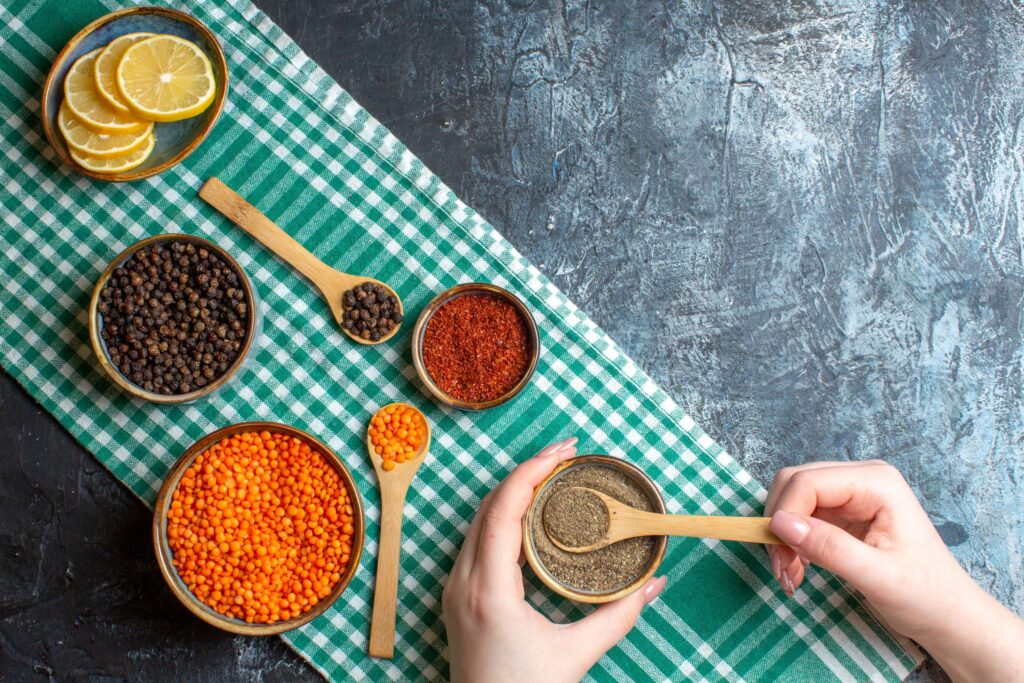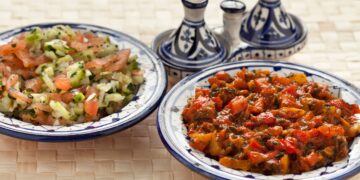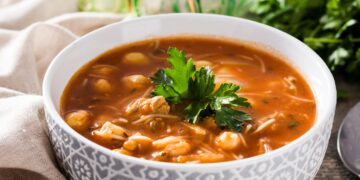In Morocco, cooking is more than preparing meals, it is a tradition that brings people together around the table. What makes Moroccan cuisine world-famous are its signature spice blends, carefully balanced to add depth, warmth, and authentic flavor. Each blend tells a story of culture and history, transforming simple ingredients into unforgettable dishes. Learning how to use these spices is the key to recreating the aromas and tastes that make Moroccan food so unique.
Ras El Hanout: The Royal Blend
If there’s one blend every Moroccan chef treasures, it’s Ras El Hanout. Literally meaning “head of the shop,” it is a crown jewel of spice mastery. A good Ras El Hanout should have at least a dozen spices, sometimes up to 30. Mine combines cinnamon sticks, dried rosebuds, cumin, ginger, nutmeg, and just a hint of black pepper. I rub it generously on lamb before slow-braising it in a tagine, where the meat absorbs every layer of aroma. Pro tip: toast the spices briefly in a dry pan before grinding this unlocks a smoky depth you can’t achieve otherwise.
La Kama: Tangier’s Secret
When I travel to Tangier, I never leave without a bag of La Kama. It’s less complex than Ras El Hanout, but it shines with warm comfort. Think turmeric for color, cinnamon for sweetness, and ginger for heat. I often stir a spoonful into harira, Morocco’s famous tomato-lentil soup, especially during Ramadan. The scent rising from the pot is enough to make hungry fasters smile before sunset. If you’re experimenting, sprinkle La Kama over roasted chickpeas or even scrambled eggs you’ll be surprised by the richness.
Harissa: Fire and Soul in a Paste
No Moroccan kitchen is complete without Harissa. Though often associated with Tunisia, Moroccans have made it their own thick, smoky, and full of life. It’s a blend of dried red chilies, garlic, cumin, and caraway, ground into a paste with olive oil. In my kitchen, I keep a jar ready at all times.
A spoonful can transform a simple lentil soup, wake up a couscous, or even act as a marinade for lamb skewers. I also swirl it into yogurt to create a spicy dip that pairs beautifully with grilled vegetables. Harissa isn’t just heat—it’s depth, smoke, and intensity, the kind of warmth that lingers long after the meal.
Building Business Partnerships Through Moroccan Cultural Events
In today’s interconnected world, businesses are constantly searching for innovative ways to establish trust, strengthen networks, and expand their reach....
Hiking Trails in the Middle Atlas Mountains
The Middle Atlas Mountains are often overshadowed by the High Atlas or the Rif, yet they hold some of Morocco’s...
From Passion to Profession: Turning Creative Skills into Income
In Morocco, more young people are transforming their creative talents into careers. Whether it’s photography, calligraphy, fashion design, or digital...
Young Moroccans Abroad: Balancing Wanderlust and Roots
For many young Moroccans, the dream of exploring the world is irresistible. Whether through study, work, or travel, living abroad...
Chermoula: The Fisherman’s Marinade
Head to the Atlantic coast and you’ll smell Chermoula before you see it. This isn’t a dry mix but a living paste of cumin, paprika, coriander, garlic, lemon juice, and olive oil. Fishermen in Essaouira swear by it for marinating sardines before grilling. In my kitchen, I also brush it over eggplant slices before roasting—they come out smoky, tender, and bursting with Moroccan character. For a quick dinner, coat chicken with Chermoula, leave it for an hour and bake, it’s a weekday miracle.

Testimonial: A Student Learns the Magic
“When I first moved out, I only knew how to fry eggs,” laughs Youssef, a 22-year-old student in Rabat. “One day, my neighbor gave me a jar of Ras El Hanout. I mixed it with olive oil, rubbed it on chicken, and roasted it in the oven. Suddenly, I felt like a real chef. Now, my friends come to me for couscous Fridays. I realized Moroccan spices don’t just flavor food , they connect us to tradition even in a small student kitchen.”
Chef’s Tips for Using and Storing Spices
Spices are alive; treat them with respect. Always buy whole when you can, cumin seeds, cinnamon sticks, cloves and grind them fresh. Store them in airtight jars, away from sunlight. Remember balance: Moroccan cuisine is never about one spice shouting; it’s about harmony. A teaspoon too much cinnamon can drown a tagine, while the right pinch can make it unforgettable. My golden rule: smell your blend before you use it, if the aroma sings, the dish will too.
Conclusion
Moroccan spice blends are the heartbeat of the kitchen. Ras El Hanout crowns festive dishes, La Kama comforts during winter nights, Harissa ignites meals with smoky fire, while Chermoula brings the coast to your plate. Cook with these blends not as powders from a jar, but as stories, traditions, and flavors woven into Morocco’s culinary soul. Once you do, you won’t just cook Moroccan food you’ll feel Morocco in your kitchen.
















Discussion about this post